Related Research Articles
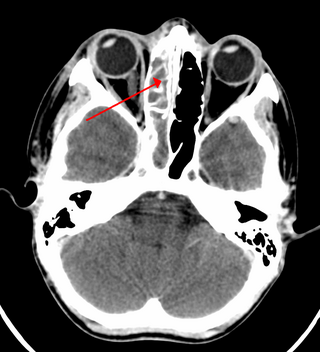
Sinusitis, also known as rhinosinusitis, is an inflammation of the mucous membranes that line the sinuses resulting in symptoms that may include thick nasal mucus, a plugged nose, and facial pain.

Surgery is a medical specialty that uses manual and instrumental techniques to diagnose or treat pathological conditions, to alter bodily functions, to reconstruct or improve aesthetics and appearance, or to remove unwanted tissues or foreign bodies. The subject receiving the surgery is typically a person, but can also be a non-human animal.

Urinary incontinence (UI), also known as involuntary urination, is any uncontrolled leakage of urine. It is a common and distressing problem, which may have a large impact on quality of life. It has been identified as an important issue in geriatric health care. The term enuresis is often used to refer to urinary incontinence primarily in children, such as nocturnal enuresis. UI is an example of a stigmatized medical condition, which creates barriers to successful management and makes the problem worse. People may be too embarrassed to seek medical help, and attempt to self-manage the symptom in secrecy from others.
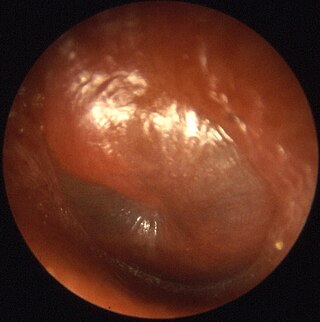
Otitis media is a group of inflammatory diseases of the middle ear. One of the two main types is acute otitis media (AOM), an infection of rapid onset that usually presents with ear pain. In young children this may result in pulling at the ear, increased crying, and poor sleep. Decreased eating and a fever may also be present. The other main type is otitis media with effusion (OME), typically not associated with symptoms, although occasionally a feeling of fullness is described; it is defined as the presence of non-infectious fluid in the middle ear which may persist for weeks or months often after an episode of acute otitis media. Chronic suppurative otitis media (CSOM) is middle ear inflammation that results in a perforated tympanic membrane with discharge from the ear for more than six weeks. It may be a complication of acute otitis media. Pain is rarely present. All three types of otitis media may be associated with hearing loss. If children with hearing loss due to OME do not learn sign language, it may affect their ability to learn.

General anaesthesia (UK) or general anesthesia (US) is a method of medically inducing loss of consciousness that renders a patient unarousable even with painful stimuli. This effect is achieved by administering either intravenous or inhalational general anaesthetic medications, which often act in combination with an analgesic and neuromuscular blocking agent. Spontaneous ventilation is often inadequate during the procedure and intervention is often necessary to protect the airway. General anaesthesia is generally performed in an operating theater to allow surgical procedures that would otherwise be intolerably painful for a patient, or in an intensive care unit or emergency department to facilitate endotracheal intubation and mechanical ventilation in critically ill patients. Depending on the procedure, general anaesthesia may be optional or required. Regardless of whether a patient may prefer to be unconscious or not, certain pain stimuli could result in involuntary responses from the patient that may make an operation extremely difficult. Thus, for many procedures, general anaesthesia is required from a practical perspective.
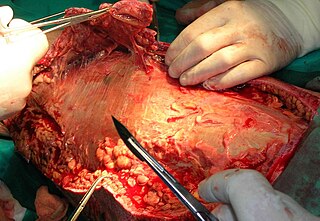
Debridement is the medical removal of dead, damaged, or infected tissue to improve the healing potential of the remaining healthy tissue. Removal may be surgical, mechanical, chemical, autolytic (self-digestion), and by maggot therapy.

Cardiac surgery, or cardiovascular surgery, is surgery on the heart or great vessels performed by cardiac surgeons. It is often used to treat complications of ischemic heart disease ; to correct congenital heart disease; or to treat valvular heart disease from various causes, including endocarditis, rheumatic heart disease, and atherosclerosis. It also includes heart transplantation.

Chlorhexidine is a disinfectant and antiseptic with the molecular formula C22H30Cl2N10, which is used for skin disinfection before surgery and to sterilize surgical instruments. It is also used for cleaning wounds, preventing dental plaque, treating yeast infections of the mouth, and to keep urinary catheters from blocking. It is used as a liquid or a powder. It is commonly used in salt form, either the gluconate or the acetate.

Pressure ulcers, also known as pressure sores, bed sores or pressure injuries, are localised damage to the skin and/or underlying tissue that usually occur over a bony prominence as a result of usually long-term pressure, or pressure in combination with shear or friction. The most common sites are the skin overlying the sacrum, coccyx, heels, and hips, though other sites can be affected, such as the elbows, knees, ankles, back of shoulders, or the back of the cranium.
Perioperative mortality has been defined as any death, regardless of cause, occurring within 30 days after surgery in or out of the hospital. Globally, 4.2 million people are estimated to die within 30 days of surgery each year. An important consideration in the decision to perform any surgical procedure is to weigh the benefits against the risks. Anesthesiologists and surgeons employ various methods in assessing whether a patient is in optimal condition from a medical standpoint prior to undertaking surgery, and various statistical tools are available. ASA score is the most well known of these.
Antiseptic lavage is a means of washing, especially of a hollow organ, such as the stomach or lower bowel, with repeated injections of warm water mixed with an antiseptic or antifungal solution. Antiseptic lavages are commonly used as a treatment to pericoronitis of wisdom teeth.
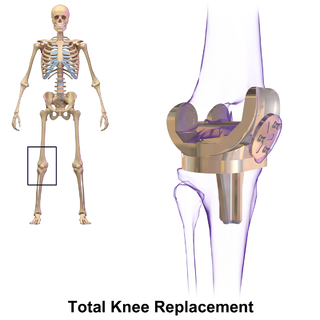
Knee replacement, also known as knee arthroplasty, is a surgical procedure to replace the weight-bearing surfaces of the knee joint to relieve pain and disability, most commonly offered when joint pain is not diminished by conservative sources. It may also be performed for other knee diseases, such as rheumatoid arthritis. In patients with severe deformity from advanced rheumatoid arthritis, trauma, or long-standing osteoarthritis, the surgery may be more complicated and carry higher risk. Osteoporosis does not typically cause knee pain, deformity, or inflammation, and is not a reason to perform knee replacement.

Venous ulcer is defined by the American Venous Forum as "a full-thickness defect of skin, most frequently in the ankle region, that fails to heal spontaneously and is sustained by chronic venous disease, based on venous duplex ultrasound testing." Venous ulcers are wounds that are thought to occur due to improper functioning of venous valves, usually of the legs. They are an important cause of chronic wounds, affecting 1% of the population. Venous ulcers develop mostly along the medial distal leg, and can be painful with negative effects on quality of life.

Respiratory tract infections (RTIs) are infectious diseases involving the lower or upper respiratory tract. An infection of this type usually is further classified as an upper respiratory tract infection or a lower respiratory tract infection. Lower respiratory infections, such as pneumonia, tend to be far more severe than upper respiratory infections, such as the common cold.
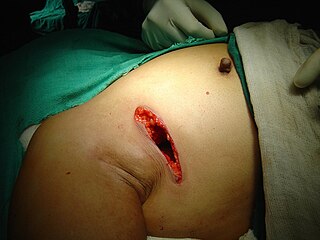
Breast-conserving surgery refers to an operation that aims to remove breast cancer while avoiding a mastectomy. Different forms of this operation include: lumpectomy (tylectomy), wide local excision, segmental resection, and quadrantectomy. Breast-conserving surgery has been increasingly accepted as an alternative to mastectomy in specific patients, as it provides tumor removal while maintaining an acceptable cosmetic outcome. This page reviews the history of this operation, important considerations in decision making and patient selection, and the emerging field of oncoplastic breast conservation surgery.
Breast surgery is a form of surgery performed on the breast.

Bacteriuria is the presence of bacteria in urine. Bacteriuria accompanied by symptoms is a urinary tract infection while that without is known as asymptomatic bacteriuria. Diagnosis is by urinalysis or urine culture. Escherichia coli is the most common bacterium found. People without symptoms should generally not be tested for the condition. Differential diagnosis include contamination.

Abdominal trauma is an injury to the abdomen. Signs and symptoms include abdominal pain, tenderness, rigidity, and bruising of the external abdomen. Complications may include blood loss and infection.
Patient Blood Management (PBM) is a set of medical practices designed to optimise the care of patients who might need a blood transfusion. Patient blood management programs use an organized framework to improve blood health, thus increasing patient safety and quality of life, reducing costs, and improving clinical outcomes. Some strategies to accomplish this include ensuring that anemia is treated prior to a surgical operation, using surgical techniques that limit blood loss, and returning blood lost during surgery to the patient via intraoperative blood salvage.
Postoperative wounds are those wounds acquired during surgical procedures. Postoperative wound healing occurs after surgery and normally follows distinct bodily reactions: the inflammatory response, the proliferation of cells and tissues that initiate healing, and the final remodeling. Postoperative wounds are different from other wounds in that they are anticipated and treatment is usually standardized depending on the type of surgery performed. Since the wounds are 'predicted' actions can be taken beforehand and after surgery that can reduce complications and promote healing.
References
- ↑ Ravindra, P; Fitzgerald, J (2012). "Surgical preoperative assessment". Student BMJ. 344: d7816. doi:10.1136/sbmj.d7816. S2CID 164318333.
- 1 2 3 Nicholson, Amanda; Coldwell, Chris H; Lewis, Sharon R; Smith, Andrew F; Lewis, Sharon R (2013). "Nurse-led versus doctor-led preoperative assessment for elective surgical patients requiring regional or general anaesthesia". Reviews (11): CD010160. doi:10.1002/14651858.CD010160.pub2. PMID 24218062.
- ↑ Bradt, Joke; Dileo, Cheryl; Shim, Minjung; Bradt, Joke (2013). "Music interventions for preoperative anxiety". Reviews. 2013 (6): CD006908. doi:10.1002/14651858.CD006908.pub2. PMC 9758540 . PMID 23740695.
- 1 2 3 Tanner, Judith; Norrie, Peter; Melen, Kate; Tanner, Judith (2011). "Preoperative hair removal to reduce surgical site infection". Reviews (11): CD004122. doi:10.1002/14651858.CD004122.pub4. PMID 22071812.
- ↑ Webster, Joan; Osborne, Sonya; Webster, Joan (2012). Webster, Joan (ed.). "Preoperative bathing or showering with skin antiseptics to prevent surgical site infection" (PDF). Protocols (9): CD004985. doi:10.1002/14651858.CD004985.pub4. hdl: 10072/51996 . PMID 22972080.
- ↑ Dumville, Jo C; McFarlane, Emma; Edwards, Peggy; Lipp, Allyson; Holmes, Alexandra; Dumville, Jo C (2013). Dumville, Jo C (ed.). "Preoperative skin antiseptics for preventing surgical wound infections after clean surgery". Reviews (3): CD003949. doi:10.1002/14651858.CD003949.pub3. PMID 23543526.
- ↑ American Academy of Ophthalmology (September 2013), "Five Things Physicians and Patients Should Question", Choosing Wisely: an initiative of the ABIM Foundation , American Academy of Ophthalmology, retrieved 6 January 2013
- ↑ American College of Cardiology (September 2013), "Five Things Physicians and Patients Should Question", Choosing Wisely: an initiative of the ABIM Foundation , American College of Cardiology, retrieved 10 February 2014
- ↑ Sheffield, Kristin M.; McAdams, Patricia S.; Benarroch-Gampel, Jaime; Goodwin, James S.; Boyd, Casey A.; Zhang, Dong; Riall, Taylor S. (2013). "Overuse of Preoperative Cardiac Stress Testing in Medicare Patients Undergoing Elective Noncardiac Surgery". Annals of Surgery. 257 (1): 73–80. doi:10.1097/SLA.0b013e31826bc2f4. ISSN 0003-4932. PMC 3521863 . PMID 22964739.
- ↑ American College of Radiology (September 2013), "Five Things Physicians and Patients Should Question", Choosing Wisely: an initiative of the ABIM Foundation , American College of Cardiology, retrieved 3 September 2014
- 1 2 Society of Thoracic Surgeons (February 2013), "Five Things Physicians and Patients Should Question", Choosing Wisely: an initiative of the ABIM Foundation , Society of Thoracic Surgeons, retrieved 18 December 2013
- ↑ Brady, Marian C; Kinn, Sue; Ness, Valerie; O'Rourke, Keith; Randhawa, Navdeep; Stuart, Pauline; Brady, Marian C (2009). "Preoperative fasting for preventing perioperative complications in children". Reviews (4): CD005285. doi:10.1002/14651858.CD005285.pub2. PMID 19821343.
- ↑ Thomsen, Thordis; Villebro, Nete; Møller, Ann Merete; Thomsen, Thordis (2014). "Interventions for preoperative smoking cessation". Reviews. 2014 (3): CD002294. doi:10.1002/14651858.CD002294.pub4. PMC 7138216 . PMID 24671929.
- ↑ Oppedal, Kristian; Møller, Ann Merete; Pedersen, Bolette; Tønnesen, Hanne; Oppedal, Kristian (2012). "Preoperative alcohol cessation prior to elective surgery". Reviews (7): CD008343. doi:10.1002/14651858.CD008343.pub2. PMID 22786514.